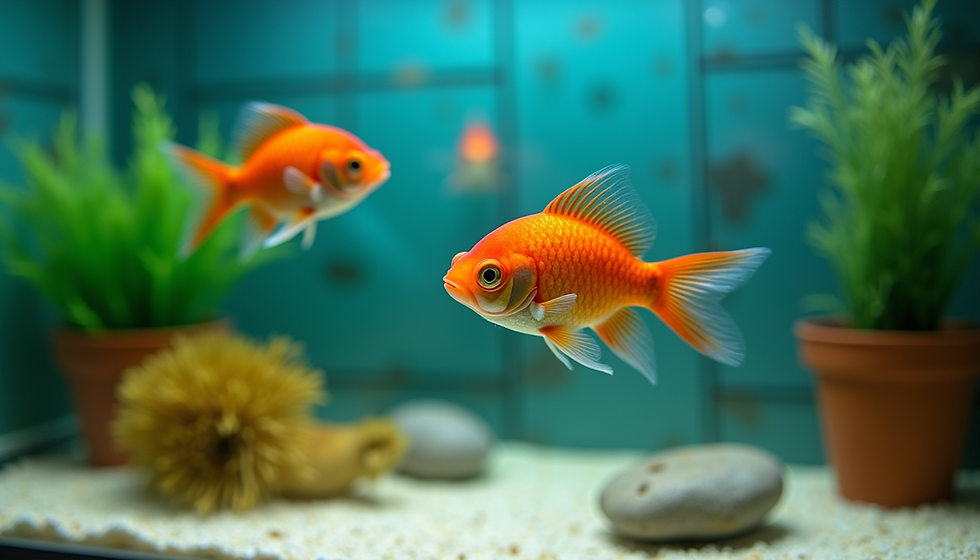Top Tips for Maintaining a Healthy Aquarium
- John Wright-Ibarra

- Jul 5, 2025
- 3 min read
Maintaining a healthy aquarium is essential for the well-being of your aquatic pets and the beauty of your home. An aquarium can be a stunning focal point, but it requires regular care and attention. From water quality to tank setup, there are several factors that contribute to a thriving ecosystem. Here are some top tips to help you maintain a healthy aquarium and keep your fish happy and healthy.
Aquarium Maintenance Basics
One of the foundational steps to maintaining a healthy aquarium is understanding the basics of aquarium maintenance. This encompasses regular monitoring and consistent cleaning schedules to ensure that the water parameters are suitable for your fish.
Water Quality: Testing water parameters such as pH, ammonia, nitrites, and nitrates should be a routine task. It’s advisable to use a reliable water testing kit to keep those parameters in check. Most freshwater fish thrive in a pH range of 6.8 to 7.8, while saltwater fish have slightly different requirements.
Regular Water Changes: Performing weekly water changes of about 10-20% can greatly improve water quality. This practice helps in removing harmful waste products and replenishing essential minerals.
Filters and Aeration: Your aquarium's filtration system plays a critical role in maintaining water quality. It's important to clean filter media every couple of weeks, while also ensuring that the filter is sized appropriately for your tank. For aeration, air pumps and bubble stones can enhance oxygen levels in the water.

Choosing the Right Equipment
The right equipment is vital for successful aquarium maintenance. When setting up your aquarium, consider investing in high-quality gear that suits the needs of your aquatic environment.
Aquarium Size: A larger tank provides a more stable environment for fish. If you are just starting, a 20-gallon tank can be an excellent option for beginners, while more experienced enthusiasts may prefer larger setups.
Lighting: Proper lighting is essential not only for aesthetics but also for the health of live plants and the fish. Consider using LED lights which are energy-efficient and have adjustable brightness options.
Substrate and Decor: The choice of substrate and décor can influence the biological activity in your aquarium. Substrates like gravel or sand can accommodate beneficial bacteria, while decorations provide hiding spots for shy fish.
How Much Does an Aquarium Service Cost?
Understanding the cost of professional aquarium services can help you plan your aquarium maintenance budget. Prices can vary depending on location, type of service, and the size of your aquarium.
Service Packages: Many aquarium services offer various packages, including regular maintenance, emergency services, and full setup and installation. The cost for regular maintenance can range from $100 to $350 per month.
One-time Services: If you require a one-time cleaning or emergency service, expect to pay a little more, possibly between $150 to $400.
Custom Rates: Some services provide custom rates based on your specific needs and tank size. It’s beneficial to inquire about a quote from local service providers. If you're searching for options, consider looking for aquarium services near me.

Feeding Your Fish
Feeding your fish properly is essential for their health and longevity. Overfeeding is a common mistake that can lead to water quality issues.
Portion Control: Only feed your fish what they can consume in a few minutes. This approach helps prevent excess food from degrading water quality.
Variety: Incorporate a variety of foods into their diet. Flakes, pellets, frozen food, and live food will provide balanced nutrition. Different species have varying dietary requirements, so be sure to research the specific needs of your fish.
Feeding Schedule: Establish a feeding schedule, ideally once or twice a day. Consistency can help your fish develop healthy feeding habits.
Regular Maintenance and Monitoring
Routine maintenance is key to sustaining a vibrant aquarium. In addition to the basics outlined earlier, observe your fish regularly for signs of distress.
Daily Checks: Spend a few minutes each day observing your fish. Look for any unusual behavior, signs of disease, or changes in appetite.
Tank Cleanliness: Regularly check for algae buildup and clean the tank walls as needed. Use an algae scraper and a siphon for substrate cleaning.
Health Monitoring: If you notice any signs of disease, such as spots or unusual swimming behavior, consult a specialist or conduct research on potential treatments.

Conclusion: The Rewards of a Thriving Aquarium
In conclusion, maintaining a healthy aquarium is a rewarding endeavor. By prioritizing water quality, investing in the right equipment, and observing your fish regularly, you create an environment where your aquatic pets can thrive.
Not only do you enhance the beauty of your home, but you also experience the joy of watching your fish swim happily in their safe haven. Remember to seek help when needed, perhaps through local partners in aquarium maintenance, to ensure you are providing the best possible care for your underwater friends. Happy fishkeeping!





Comments